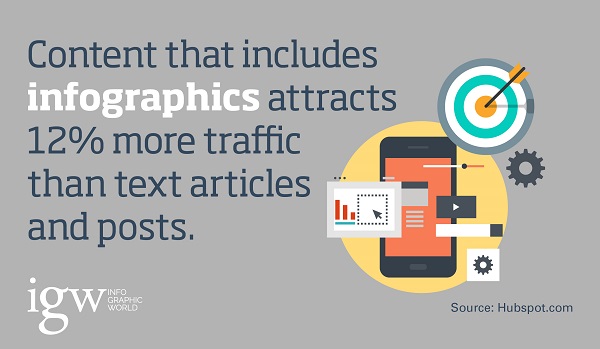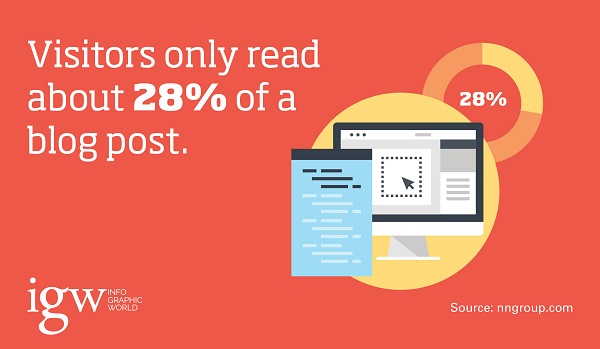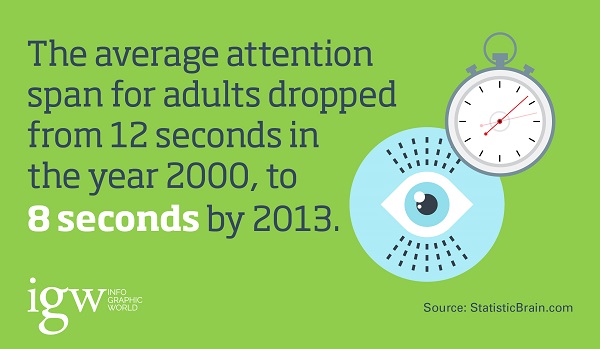Leverage Visual Marketing To Scale Your Inbound Lead Flow Today
Face it-not everyone that visits your website is interested in thoroughly reading your 2000 word articles. In fact, most people don’t actually read them, but they instead skim through and pick up bits and pieces of key information. This is done for either one of two reasons, one being that the reader just doesn’t have time. The other, and more common reason, is that their attention span just won’t allow them to. When you’re dealing with the latter, it’s important to be able to deliver content in a direct manner, and this means keeping it short and sweet. Here are a few ways you can do that without sacrificing creativity.
Mini-graphics
Mini-graphics are short infographics or interactive graphics that focus on a single fact or piece of data. These are best used for quickly disseminating information to readers short on time and attention. Mini-graphics are most employed on social media, but they are just as effective when used on a company’s website or blog (here’s an example of a post utilizing mini graphics). The key to capturing the reader with the short attention span is to focus on one key piece of information, and to use images that are eye catching and relevant to the material that you’re sharing.
- Fact: Content that includes infographics attracts 12% more traffic than text articles and posts.
- Tip: Minigraphics are easy and inexpensive to create. Use them several times per week in your content marketing strategy to quickly deliver tidbits of important information.
Short Lists
When dealing with short attention spans, short lists can be just what the doctor ordered. While producing this type of content, use a maximum of five bullet points to cover, and always use the number in the headline (5 Reasons to Get Up Early, 3 Most Shocking Things You’ll Do Today, etc). Shorter lists tend to have meatier content– meaning it gets straight to the point and has little to no fluff. As a typical rule, 300-400 words is the max for this type of post, and one image is all that’s needed.
- Fact: Number of readers that click beyond a headline:1 in 5
- Tip: Make sure your headline is well written to maximize readership.
How to Articles
How to articles can also be short and sweet. Be sure to clearly present each step, and only use material that is relevant to the topic (in other words, no fluff). Always use an active voice when writing how-to pieces, and consolidate steps in the process whenever possible. If you can turn a ten step post into a five step post, by all means do so. Readers will appreciate your respect of their time, and will more than likely return to your website in the future. Remember,when people look for how-to articles, they want to quickly find what they need, and move on.
- Fact: Only 4% of pageviews last more than 10 minutes.
- Tip: Whenever possible, use custom images and graphics for how-to articles.
Tips and Tricks
Another type of article that people with limited time and attention spans enjoy are tips and tricks. These are typically short by nature, as no one wants to read 2000 words of helpful hints when they’re in the middle of trying to solve a problem. The key to making this work is to think like the reader. Ask yourself if you were in their situation, what would you look for, and how would you want the information presented to you. Your tips and tricks content should be educational, and offer some not-so-common advice. Keep the 300-400 word limit in mind, and only address one problem or issue per post.
- Fact: Visitors only read about 28% of a blog post.
- Tip: To cover an issue that requires longer, more in depth content, break the post up into sections, and feature one section on specific days of the week.
FAQ Articles
If you find that customers are asking the same questions about your product or service, create a FAQ section on the website, and then a weekly FAQ blog post that deals with a specific issue in more detail. This would be highly beneficial for readers that want answers to a specific question, and does not take a lot of time for you to produce. You could also create a mini-graphic to go along with the post to add some visual appeal. Readers will more than likely share the infographic than the article if it’s helpful and contains information that they were looking for.
- Fact: The average attention span for adults dropped from 12 seconds in the year 2000, to 8 seconds by 2013.
- Tip: An FAQ blog post could be no longer than 200 words.
Social Media Posts
Businesses have finally began to realize that social media is beneficial for much more than promoting a product or service. People look to these platforms as a resource for all sorts of information, including educational and entertaining content. Use your social channels as a way to give customers an update, or to share valuable pieces of information about your business. It’s a great way to deliver a message without having to create an entire article, and definitely fits the definition of micro-content. Make sure that you promote your social channels on the company website, and have some content that is exclusive to these platforms (meaning visitors will need to follow you on social media to have access to the material). This exclusivity will help to increase social media traffic.
- Fact: Baby Boomers are the most rapid growing age group among Twitter users.
- Tip: Don’t try to be everywhere at once. Find out what social channels the majority of your readers use, and focus on producing content exclusively for them.
Experiment with different types of micro content, and don’t be too shy to ask readers what they prefer. Conduct a poll to find out if they favor graphics, video, or text. You may be surprised at what you learn, and you’ll gain the trust of your readers by asking their opinions.
Getting a reader with a short attention span to remain on your site can be tricky, but it’s definitely doable. Use these tips to help you produce content that’s easy to digest, and solves a specific problem. If you’re not going to add images, remember that micro-content in text form should top off at around 300 words. Images and graphics should be small, and target one key piece of information.
Leverage Visual Marketing To Scale Your Inbound Lead Flow Today












Leave a Comment